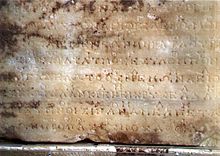Delphic hymns
The Delphic Hymns are the most extensive of the very few surviving examples of ancient Greek music . The two hymns to Apollo are carved in stone at the Treasury of the Athenians in Delphi . They probably date from 138 and 128 BC and were published in 1893/94.
The Paian from Delphi from 138 BC. Chr. Shows very nicely the use of the tetrachord synemmenon with the note symbol Λ in the last line: Here the previously used tetrachord g 'f' es 'd' is replaced by the synemmenon phrase f 'es' of the 'c'.
The ancient Greek text goes something like this:
Hear me, you who own the deep forest of Elikona, you fortunate daughters of the great Zeus! To deceive with your words, fly your brother Phoebus with the golden hair, from the twin peaks of the rock Parnassus, accompanied by the splendid Delphic Virgins, his journey begins to the crystal waters of Castalia, crossing the Cape of Delphi, the prophetic mountain .
Individual evidence
- ↑ For more recent research see Egert Pöhlmann : " Denkmäler oldgriechischer Musik " = Erlanger Contributions to Linguistics and Art Studies Vol. 31, Nuremberg 1970
Web links
- Music archeology
- all ancient Greek fragments in sound samples
- Σκέψεις για την προφορική, λαϊκή, μουσική μας παράδοση
- CD "De la Pierre au son: musiques de l'Antiquité grecque", Ensemble Kérylos (K617.069), dir. Annie Bélis

